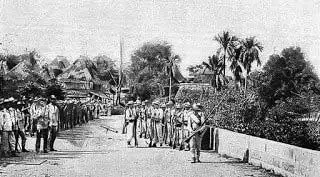Part VI: US Military Operations in Batangas from 1901-02 during the Fil-American War
[In this article: Philippine-American War, Batangas Province, Macabebe Scouts, Batangas City, Tanauan Batangas, Lipa City Batangas, Balete Batangas, Nasubu Batangas, Taal Batangas, Tiaong, Mount Malepunyo, Bauan Batangas, San Juan Batangas, Taysan Batangas]
This article continues with series we have running on Batangas History which details United States Army operations conducted in the Province of Batangas from 1901 to 1902. The details are taken from the annual report of the United States War Department for the fiscal year1.
These bits of information one will likely not find in history text books, albeit written but naturally from the American point of view. They are presented in snippets and arranged in chronological order as they appeared in the original annual report. Readers who missed the earlier installments will find these archived under the Fil-Am War section of the main menu at the top of this page.
11 January 1902
In the town of Bauan, Filipino rebel Captain Miguel Cuevas Cruz, bringing with him two rifles and one revolver, surrendered to Captain John D. L. Hartman of the United States Army’s 1st Cavalry.
- Massive surrender of Filipino rebel troops in Taal to Captain George H. Morgan of the 3rd Cavalry and Captain John P. Ryan of the 6th Cavalry. The Filipinos were led by one Colonel Marasigan and included three companies of the Battalion de Gracia, two companies of the Battalion Payapa and one company of Battalion Luyong. With the group aside from Marasigan were three lieutenant colonels, one major, five captains, 12 lieutenants, 245 enlisted men as well as 224 rifles, 10 revolvers and about 5,000 rounds of ammunition.
- At the Taysan and San Juan de Bocboc Road, Captain De Rosey C. Cabell of the 6th Cavalry, accompanied by two scout companies, encountered and engaged several bands of Filipino rebels. They killed four of the rebels and captured three, along with their equipment amounting to one Mauser and three Remington rifles. They also destroyed outpost buildings of the rebels.
- Filipino rebels under the command of one Lieutenant Colonel Briccio Laqui, accompanied by one major, two captains and five lieutenants, and bringing with them 39 rifles and 950 rounds of ammunition, surrendered to 1st Lieutenant Samuel W. Widdifield in Cuenca.
- In the town of Lipa, one Filipino rebel captain, accompanied by one lieutenant and five privates, bringing with them 7 Remington rifles, 4 Mausers, one revolver, 600 rounds of ammunition and some official papers, surrendered to 2nd Lieutenant Frederick B. Hennessy.
- In the town of San Jose, Filipino rebel Agustin Dimaculangan surrendered with 131 of his men and 38 rifles, 8 revolvers and 44 bolos.
- In the town of Batangas, Filipino rebels Colonel Damaso Ybarra, Major Lucio Buenafe, Captain Eutalio Buenafe and 5 lieutenants and 22 soldiers with their 21 rifles, 3 revolvers and 9 bolos surrendered to the Americans.
- In Nasugbu, a group of some 23 Macabebe and 3 civilian scouts under the command of one 1st Lieutenant Joseph Herring of the 24th Infantry discovered a rebel manning an outpost two days earlier. The rebel tried to flee after being fired upon but was subsequently captured. He then led Herring’s group to a cuartel which was being used as a meeting place for rebel operations in the area. The rebels they came upon managed to slip away. On the 30th of the month, the US Army detachment returned to the cuarterl and killed one rebel, capturing six others along with about 8 to 10 tons of rice.
- Comandante Antonio Mandigma of the Filipino rebels surrendered to the Americans in the town of Lipa, bringing along with him five captains, four 1st Lieutenants, three 2nd Lieutenants and 67 enlisted men along with 34 guns, 3 revolvers and a lot of ammunition and bolos.
- The commanding officer in the town of Lipa reported that Colonel Manuel Reyes surrendered, along with one captain, one 1st Lieutenant and 18 enlisted men with 14 good rifles, 2 good shotguns and one pistol.
2 A “pack train” is a line of animals.

